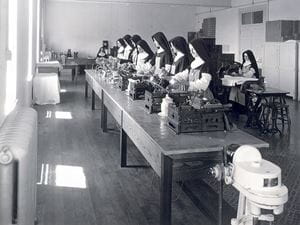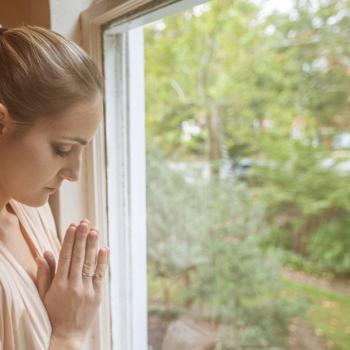
Religion Behind the Scenes spotlights the crucial but less visible tasks that keep religious communities running, and the people who make it all happen.
The Benedictine Sisters of Perpetual Adoration have been baking altar breads in their Missouri monastery since 1910. As the largest religious providers of altar breads in the US, they ship over eight million hosts in a typical month. In recent decades, they’ve become known for a more specialized service: Low gluten hosts. Under Catholic Canon Law, hosts (the thin wafers used for communion) must be made of wheat, which is by definition gluten. No substitution allowed. This meant Catholics with celiac disease or gluten sensitivity were unable to partake in communion through the host.
What's the solution? Read our ‘Behind the Scenes’ story with Sister Lynn D'Souza.
Okay, first and most obvious question: How did you get involved with making low gluten hosts?
I entered the community in 1999, and we were already back then getting calls from people asking about gluten free bread. And of course, we had nothing. There were a couple of other sisters who were here at the time fielding those calls, and they started taking the names of people that were requesting it. We would tell them ‘we don't have anything at the time, but if something comes along, please give us your name and address and we'll notify you.’
Now, one day I came into the kitchen, and there was another sister, her name is Sister Jane Heschmeyer, and she and another sister who had been taking those calls were kind of experimenting and trying to figure out proportions and ratios. Because the whole dilemma, of course, is that those with gluten sensitivity say no wheat, and the Church says wheat only. My background is in biomedical science, which was my undergraduate degree, and I have always had a more of scientific, mathematical bent of mind. So when I entered the kitchen and saw what they were doing, I said, oh, a science experiment! I want to do it! I want to do it! And they were like, feel free.
Nothing came of that experiment on that particular day, other than my interest was piqued in the whole process of low gluten altar breads. But another year or two down the road, I actually got assigned to work in the altar bread business office where I was in customer service, and I too started getting calls from people. I mean, I don't want to say once a week, but we were getting enough calls that it was enough to say: Wow, there's really a need out there for this.
I thought, let's start experimenting again. This was probably 2002. And what changed this time is that we actually were in touch with the USCCB, the US Council of Catholic Bishops. And they recommended a couple of different variations of wheat starch for us to try, where they thought the gluten content was low enough that it would be acceptable for those with celiac disease, but it was pure wheat product so it would be acceptable to the church.
And we started experimenting.
And, you know, we had no idea what to do. We got some waffle irons, because we knew we couldn't use our regular equipment. First of all, our regular equipment is huge. And there would be cross contamination because of course we use flour on that all the time. So we tried a lot of different things. And most of the times the batter would spread out on the waffle iron like lace. It wasn't cohesive. It wouldn't stick together. Or it would become like hard plastic discs, and be just inedible. The nature of the wheat starch is that it tends to thicken fairly quickly. We had a couple of different kinds of wheat starch, and it was about getting the balance right.
In the summer of 2003, Sister Jane, who I mentioned before, and I were pretty much exclusively working on this at this point. One evening, we said well, let's, let's try mixing the two different kinds of wheat starches together. And we tried that, and the batter was so sticky…I can't even describe it. It was just gluey and sticky. We couldn't get it off the spoon, we could barely, try to scrape it off with our fingers. And we kind of just, you know, flung it down on the waffle iron. And we closed the waffle iron. And we said, I don't think that's gonna work. And then we open the waffle iron, and there was a beautiful bread there. And we immediately tasted it, and it was crisp, and it was light. And we were like, hey, this could work.
The biggest issue at that time was getting the batter consistency right, to make it pourable. That took a little bit longer time. But we had the beginnings of the recipe at that point.
And then what happened?
Oh, let me back up! The whole reason that the US CCB had gotten involved in all this, is that there was going to be a meeting in Rome, and specifically one of the questions that was going to be addressed was whether a young man who had celiac disease could be ordained a priest, because if he could not consume the host, he could not be ordained.
So they were pushing for us to have a definitive answer by the time this meeting took place. And it was that summertime that we had kind of amped up our experimentation. So like I said, we finally got the recipe to the point where we could mass produce them, or just make more of them, so we made enough to send to both the US CCB for their inspection, and we also sent enough to get it tested at the American Institute of Baking, to get an official test of gluten content.
I want to say this was probably August or September of 2003, when we got the results back that it was less than .01 percent gluten. And the USCCB said this meets the church's requirements. We then went back to that list that we had been keeping, which had probably close to 200 names on it, of people that had inquired about low gluten altar breads. And we sent a letter out to them and saying, ‘we have a product, and we are wondering if any of you would be willing to try it and let us know if you have a reaction to this.’
And I'm not remembering everybody's names right off the bat, but we had a couple of responses. I know one of them was a medical doctor that herself had celiac disease, and she said, I'd be happy to test this. Anyway, we sent out several sample packs, and we waited to hear from them. And they all came back saying these breads seem to pose no health problems for us at all. So we were very, very grateful, and at that point, we knew we had the okay from the celiac community and the church that these breads were would be acceptable.
We tentatively started selling them in January of 2004.
The other thing that happened was there was a group called the Center for Celiac Research and Treatment, and there was a well known doctor named Dr. Alessio Fasano. Someone else had referred our breads to him. I can't remember if we sent him the sample, but he ran his own tests on them. And in some newsletter that goes out to the celiac community, he said, these breads are safe for consumption for celiacs, and you would have to eat some 200 of them in the course of one day to build up an amount of gluten that would be a problem. Basically, that gave us the stamp of approval from everybody we needed, and that's when sales kind of just took off.
Did this work change your relationship, at all, to receiving communion?
You know, I went into the project with some naivete, not realizing the implications it would have for the church and not realizing fully the need that was out there. And it was so humbling, honestly, when we first started sending the breads out and getting letters in response from people. There was a 60-year-old woman who wrote and said she hadn't been able to receive communion for 40 years, and it felt like her first communion. There was a mother that wrote in and said, ‘my son had always talked about being a priest, and he didn't think it was possible because he couldn't receive the host. And now that dream is alive for him again.’ You know, we had little kids writing and saying, ‘thank you, because I can make my first communion with my classmates.’ Stuff like that. That's just so humbling. Because we didn't know. We just didn't know that there would be this response. I feel gratitude for the fact that the Holy Spirit was able to work through us.
But the other thing too is just a deepening of my own sense of appreciation for the Eucharist. When I heard how many people hungered and longed for it for so long and couldn't receive it, you know? You just don't take it for granted in the same way. And I have to say that's been renewed these days of quarantine. Because we've been blessed to have a community of Benedictine monks down the road from us, and they've been gracious enough to continue providing mass for us during these days of quarantine, so we've not had to go without Eucharist. And then to hear how much people have longed to go back to church, and how much they longed to receive the Eucharist, is just a reminder that wow, we're really blessed. And not to take that for granted.
What are some questions or misconceptions about low gluten hosts you’ve encountered?
The question many people ask is: How come? Why does it need to be wheat? If Jesus had been in Japan, he would have used rice. And so my understanding from what the church has said is that Jesus chose a specific time and a specific place and a specific people to enter into the course of human history. And we have to honor and respect that choice. And the church themselves feel that they do not have the authority to change that.
Another thing that does come up every once in a while is the whole idea of, well, if you had enough faith, the regular host wouldn't bother you. Because if you really believed it became the body of Christ, it wouldn't matter that it was [originally] wheat. To which the church has always said that while the essence of substance becomes Christ, the accidents, the physical nature, remains bread. That's why they allow for grape juice that has not been strongly fermented, mustum wine, to be used for priests that have alcoholic issues, because that's an issue for some priests. But it's not a matter of faith, where if you believe enough, it won't affect you.
So, did you solve the problem? Is this the end of the issue?
Now, I think there probably are some that are so sensitive that even this bread doesn't work for them, or they're hesitant to try it because of their sensitivities, and their own physical experiences. We respect that, and we say do not use these breads without your doctor's permission. But like I said, for the most part, we have not heard that people have had any problems with them.
For people who really say ‘I can't take the host’ our first suggestion is to ask, if possible, would you be able to receive from the cup alone? For a long time, the chalice wasn't always offered. Certainly, before Vatican II people never received from the chalice, it was only, only through the host. But after Vatican II, the church said, you know, the fullness of the sign is to receive both the bread and the wine.
Now part of part of the issue with that is because there is a piece of the ritual where a tiny fragment of the host is broken off and put into the chalice. And so some people can't take that then because the bread has been put into the cup. So if that is not an option, then people do something that is currently happening in churches, which is that you make a spiritual act of communion, which is a short prayer that basically says ‘I desire you to receive you sacramentally, Lord at this moment, but because I cannot I ask you to come into my heart spiritually’.
If receiving communion through the cup, or the wine, is an option, why do so many people still try to find a way to receive communion through the host?
I think it is because the host for such a long time has been the only sign, that it has been granted much greater status, for lack of a better word. The other thing too, is the whole concept of Eucharistic Adoration, which is very popular in the church, which is usually done only with the host because I mean, you can put it in something where it's visible. It draws people in a different way. And, you know, to break bread with someone, to take and eat…somehow is just a little more tangible or concrete I think then the cup.
Also, the church said the cup should be offered when it is feasible to do so and when it can be distributed properly and in a respectful manner. So to this day, there's a lot of places that still don't offer the chalice to the people simply because there are not enough administrators, or they lack a way to do it reverently.
You sell all over the world. Who are your customers?
I want to say in the first years of selling the breads, really, we sent breads to every continent, maybe except for Antarctica. We were so shocked! Our regular altar breads are predominantly just in the continental United States, with occasionally a shipment to an Air Force Base in Alaska, you know? All of a sudden to have international shipments was very new for us. We got orders from all over the world, initially, because we were the only ones making it.
And we have to package it specially, because we needed to keep it separate from the production we had downstairs, to guarantee it would be wheat-free. We still don’t sell our breads wholesale, like to church supply stores or things like that, because we can’t guarantee what happens to them. Its our names on the package, and if someone says ‘I got sick’ we can’t say, ‘well we don’t know what happened to your bread after it left our place.’ The only exception is Canada, because we were getting so many orders from Canada that the shipping was becoming insane. People were paying almost as much for shipping for as they were for the breads! There is a group of sisters in Canada that sell altar breads, and we have been friends with them for many years, because we use similar equipment and we’ve talked about recipes, and when issues come up with baking, we’ve been resources for each other. We asked them if they would be our distributors in Canada for low gluten altar breads, and they said yes, so we ship them bulk orders which they then distribute to the Canadian customers.
I think what happened for most people in those early days was that they would bring their host to church in a pyx. And then that would be placed on the altar. And then after a consecration, there would have to be some communication with the priest as to when they went up to receive their bread, and whether they had to go in a certain line, things like that. And that pyx would be there for them to receive there. Those little details have to be worked out individually on a parish basis, because everyone does things slightly differently.
Outside of the low gluten hosts, how big is the operation?
If you could come and visit, which I know you can’t, you would see it’s huge! I mean, one mix for our regular altar breads is about 95 pounds of flour, and 16 gallons of water, in a high pressure mixer. It's just humongous quantities! We've taken a huge hit during Covid-19, but in our pre-Covid numbers, we were making about eight million hosts per month.
Our community has been making altar breads since 1910, and we are the largest religious producers of altar breads. There's a company out in Rhode Island, called Cavanaugh, that’s the largest producers of altar breads in the US, but we are the largest religious producers.
We actually have quite a few lay employees, so it's not always entirely the sisters that are working in the department, but it's traditionally been one of the first assignment for someone who enters community. This is so they get a sense of the history, of the work of our community, and we try to instill in them that, you know, all work is good. All work is holy. All work has dignity. Even if it's something as lowly as sitting on a conveyor belt looking over the altar breads, there is a sense of the importance, because this is going to become the body of Christ.
Interview conducted, edited, and condensed by Shira Telushkin
Shira Telushkin is the managing editor of special projects at Patheos, where she combines her love of stories with her love of all things religion. A graduate of the Harvard Divinity School, she writes, edits, and produces media projects related to faith and beauty in all their forms.
7/13/2022 10:01:28 PM




